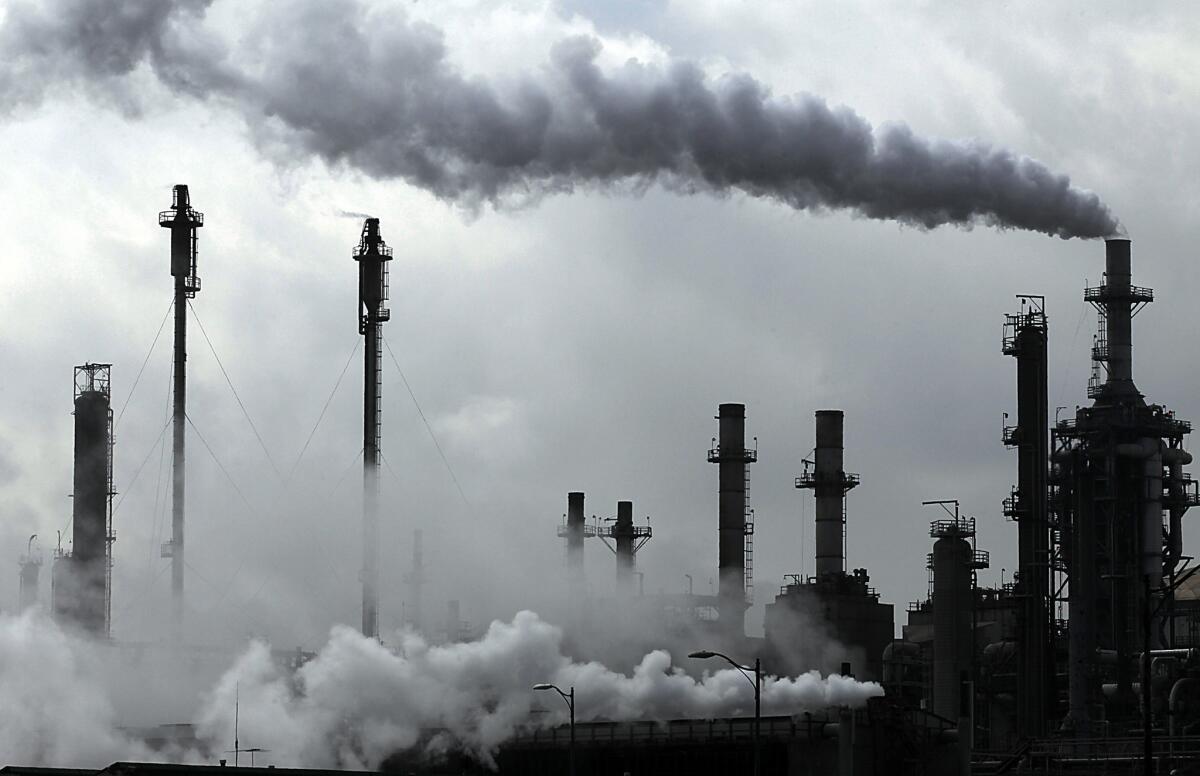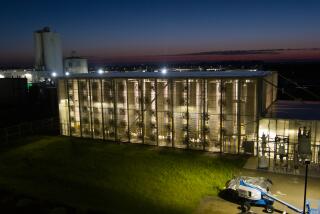Man-made climate change may need man-made remedies, science panel says

Reporting from Washington — Alarmed by the rapid pace of climate change, a key federal science panel is urging a major research effort into high-tech schemes that could cool the planet if prevention fails, potentially including giant machines to suck greenhouse gases from the air, aerosol sprays shot into the atmosphere to reflect sunlight back into space, and fertilizers for the ocean to boost growth of carbon-hungry plants.
Technologies to dial down the planet’s thermostat have long been considered a sideshow in the debate over global warming, largely dismissed by scientists as unworkable and potentially dangerous. But a comprehensive study released Tuesday by the National Research Council, the government’s main scientific advisory body, concluded that such interventions may be needed to avert a climate catastrophe and that the government should act now to figure out which might be most feasible.
“Let’s hope it never happens, but if we ever have our back against the wall, we will know ahead of time what we need to do,” said Marcia McNutt, the former head of the U.S. Geological Survey, who chaired the committee.
“These are not solutions that we want to turn to,” added McNutt, who is currently editor in chief of Science magazine.
The panel’s report is certain to be controversial. Environmental activists have long considered so-called geoengineering schemes to be distractions that threaten to take the public’s focus off the need to rapidly reduce emissions of carbon dioxide and other gases that contribute to warming. The report emphasized that those emission-reduction efforts must remain the priority.
But the federal government needs to have every possible tool available to keep climate change under control, the panel advised. It warned that even if the U.S. were to shun the new technologies, other countries might try to deploy them, whether they had been fully vetted or not.
The lack of progress for more than two decades on reducing greenhouse gas emissions makes it “increasingly likely that as a society we will need to deploy” some technologies to reduce Earth’s temperature, the report said.
The technologies that scientists think could work on a global scale are particularly risky and potentially could set off devastating changes in weather patterns. The panel’s conclusion that even those techniques might be needed at some point reflects how dangerous the climate situation has become, McNutt said.
Environmentalists greeted the panel’s report cautiously.
“The billions of tons of climate pollution that we put into our atmosphere every year are causing serious changes to the climate,” said Steven Hamburg, chief scientist for the Environmental Defense Fund. “The way to address the problem is [to] cut the pollution. But given the urgency of this challenge, some are also exploring geoengineering. We come to this issue very concerned about the danger of unintended consequences, but agree that further discussion makes sense.”
The research council’s work was divided into two lengthy reports. One assessed technology to remove carbon dioxide from the atmosphere; the other looked at techniques to reflect more solar radiation back into space.
The direct removal of carbon dioxide is a less dangerous approach, but has high costs, would take decades or even centuries to make a difference and is not yet ready to be deployed. Accomplishing the goal would involve giant machines that filter carbon dioxide out of the air, but counteracting today’s emissions would require 30,000 such devices, according to a separate estimate by Riley Duren, chief systems engineer of the Jet Propulsion Laboratory’s Earth science branch.
Absent a huge technological advance, getting rid of fossil fuels altogether would be cheaper than that type of geoengineering, the panel concluded.
Another approach would involve fertilizing the oceans with iron to increase marine vegetation that would absorb carbon dioxide. New forests could also be planted, but they would require vast areas of land, much of which is now dedicated to agriculture.
Another big problem with carbon-reduction efforts, even those as benign as planting more forests, is time. They could take centuries to have an effect on temperatures. And because of the complexity of nature, gains made through one process could quickly be wiped out by another. Reducing carbon dioxide in the air, for example, could trigger a massive release of the gas from the world’s oceans.
Increasing Earth’s ability to reflect heat back into space, what scientists refer to as the planet’s albedo, could be faster and cost less but carries a higher risk. The council recommended increased research into measuring the albedo as an important step.
One technology touted by geoengineering enthusiasts to increase reflection would involve spraying massive amounts of aerosols into the air to mimic the effects of a volcanic eruption. The aerosol canisters would be filled with sulfur dioxide, which permeated the air around Mt. Pinatubo in the Philippines after its 1991 eruption. The average global temperature dropped about 5 degrees during the three years after that eruption.
But while the average temperature would drop, the effects might not be uniform. Some regions could actually grow warmer, and rainfall patterns could be disrupted.
Thomas Prince, director of the Keck Institute for Space Studies at Caltech, said climate intervention had the same complexities as medical intervention in an illness, requiring scientists to know whether a cure is worse than the disease. The institute did its own study in 2011, calling for more spending on satellites to more precisely measure changes in Earth’s reflectivity.
The report could usher in a significant shift in the federal government’s $4-billion climate research program. Only a small fraction of the funds — $100 million — is currently directed at geoengineering. The panel recommended a significant, albeit unspecified, boost.
The scientists acknowledged that developing tools to counteract global warming carries a “moral hazard” — nations may become even less motivated than they are now to take immediate steps to combat climate change. But an even greater risk may loom if the tools are not developed and are needed in a climate emergency, they said.
The report “is a game changer,” said Simon Nicholson, co-director of the Forum for Climate Engineering Assessment at American University. While Nicholson welcomed the findings, he warned that pursuit of geoengineering technologies comes with political complications.
“Countries that do not want to take action on climate change can say if the U.S. is doing this, it means it is not serious about reducing greenhouse gases,” he said.
Vartabedian reported from Los Angeles and Halper from Washington.
More to Read
Sign up for Essential California
The most important California stories and recommendations in your inbox every morning.
You may occasionally receive promotional content from the Los Angeles Times.












